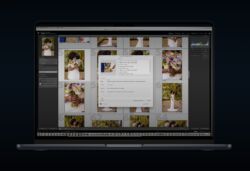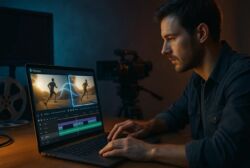Shutter speed chart

Shutter Speed Technical Explanation
Shutter speed is one of the three main factors in a camera’s exposure, part of the exposure triangle. (Along with Aperture and ISO) Changing the shutter speed alone will always result in a brighter or darker shutter speed
Shutter speed, like aperture, is often (but not always) measured as a fraction. This is why a 1/10 sec shutter speed is actually brighter than a 1/100 or 1/1000 shutter speed.

NOTE: Unfortunately, cameras often do not clearly mark the numerator (the 1/x) portion of the fraction, and some confusion can arise because there is an overlap between some whole second shutter speeds and the fractions. For example, 30 seconds and 1/30 sec. To denote a whole second, cameras usually use a single quotation mark, such as 30″ for example. Fortunately, newer cameras sometimes denote the fraction, depending on which LCD display is being viewed, thus clearing up confusion.
Speaking of confusion: similarly to how photographers reference aperture changes in many different ways, there are numerous ways that photographers describe shutter speeds. Faster, shorter, and higher all denote a darker shutter speed, while the converse terms, slower, longer, and lower all denote a brighter shutter speed.

How a camera shutter works
If a camera’s shutter is inside the camera, then it is a focal plane shutter. A focal plane shutter is actually two separate shutters, both of which are spring-loaded to travel in the direction to create the actual exposure itself. One of the shutters performs the “opening” of the shutter to expose the image, and the second shutter performs the “closing” by following the shutter across the sensor or film area.
For many slower shutter speeds, these two sequences of opening and closing happen at separate times, even if just a fraction of a second. Meaning, the shutter opens completely, exposes the sensor or film for the allotted time, (say, 1/60 sec) and then the shutter closes.
However, to achieve extremely fast shutter speeds, the opening and closing actions may not take place simultaneously. This is because the shutters themselves take a certain amount of time to open or close, say, 1/200 sec. If a shutter can only open or close that fast, then how does it achieve a shutter speed of 1/500 sec, or 1/1000 sec? The answer is that the closing shutter starts closing before the opening shutter is fully open. This allows the exposure (the effective shutter speed) to be faster than the shutter’s physical speed itself.

Flash Photography and High Speed Sync Shutter Speed
Because of the way a focal plane shutter achieves high shutter speeds, however, problems arise when attempting to use flash. If the image sensor or film is never actually fully exposed at any given moment during the shutter speed, a single flash “pop” would only illuminate a portion of the image, and the rest would appear darker or entirely black, because of the shutter is blocking the light.
This issue creates what is known as the flash sync speed for a camera. The flash sync speed is the fastest shutter speed that is possible using ordinary flashes and a single “pop” of the flash. On most modern cameras, the flash sync speed is 1/200 or 1/250 sec.
Beyond this flash sync speed, any faster shutter speeds will require a flash that is capable of high speed sync. High speed sync is where the flash itself pulses in bursts that evenly illuminate an image while the opening and closing shutters travel across the focal plane.
Common shutter speeds
There are many commonly used shutter speeds which create a variety of effects. Here are a few shutter speeds and their effects or purposes:
Millionths of a second, or microseconds, are used to photograph bullets and nuclear explosions.
Thousandths of a second, such as 1/8000 or 1/1000, are more common shutter speeds easily achieved by modern cameras, and can freeze the motion of almost any “ordinary” fast moving object or action sequence.
Hundredths of a second, such as 1/100 or 1/500, can be used to freeze most normal motion, and also to avoid image blur caused by camera shake.
Tenths of a second, such as 1/10 or 1/60, are usually when motion blur begins to come into play, depending on the motion of the subject or the camera. For example, 1/10 or 1/30 sec are useful shutter speeds for intentional panning motion, depending on the motion of the subject.
Whole seconds, such as 1″ or 10″, are used when varying degrees of motion blur are desired. For example, human subjects walking, cars driving, and water motion.
Long shutter speeds such as 30″ or 1 minute are used for extremely low light photography, such as landscape astrophotography, or for daytime motion blur when using an extremely dark neutral density filter.
 Nikon D800e, Rokinon 14mm f/2.8, 30 sec shutter speed, ISO 6400, f/2.8.
Nikon D800e, Rokinon 14mm f/2.8, 30 sec shutter speed, ISO 6400, f/2.8.
Most cameras also offer a “B” mode or Bulb Mode either on the Mode Dial or at the end of the Shutter Speed selection. This mode is essentially a manual shutter mode, where the shutter curtains will stay open as long as you hold the shutter button down, and will only close when you release that button. Therefore, you can actually leave the shutter open for minutes to even hours if needed.
An example of when you want to use the Bulb Mode is for night sky photography, where you would leave the shutter open for many minutes to record the star trails. The reason you want to do this is because the stars in the night sky emit such a low amount of light that in order for the camera to effectively see it, the shutter must be open for a long time.
The word Bulb actually refers to the old days of photography where the camera shutter is held open by a rubber bulb attached to the camera via a shutter cable. The photographer would squeeze the bulb to keep the shutter open and then would release it to close the shutter.
Shutter Speed and Motion
Besides for dialing in the “proper exposure,” you can use the shutter speed to creatively freeze or show motion. A relatively fast shutter speed freezes motion, which is great when you want to capture someone jumping in the air without creating any motion blur.

A slower shutter speed is used when you want to convey motion. This gives a sense of dynamic direction and makes the object looks like it is really moving. In the example below, the exposure time is 13 seconds. This made it look like the cars were moving so fast that they were only leaving light trails behind them.

Shutter Speed and Motion Shakiness
One of the consequences of a slow shutter speed is that the sensor will start to pick up any camera vibrations that can occur while the shutter is open. This tends to happen when you are hand-holding the camera instead of securing it on something more stable like a tripod. There is rule of thumb called the reciprocal rule that states that whatever is your lens’ focal length, that is the slowest shutter speed that you should shoot at without introducing any shaky blur into your shot. So for example, if you are shooting with a 200mm lens, you want your shutter speed to be at least a 1/200 sec or faster.
Conclusion
So to recap, the shutter speed is the measurement of how long the camera shutter stays open to allow light to hit the sensor. It is measured in fractions of a second up until 1 second and then measured in whole seconds for longer exposures. You use it in conjunction with aperture and ISO in order to get a proper exposure. You also use it as an artistic tool to freeze or convey motion in a photograph.
Finally, if you are using a shutter speed that is a slower value than your lens’s focal length, be sure to stabilize your camera in order to minimize unwanted blur.
That’s it for the basics of shutters speed. Next, we are going to talk about the basics of aperture and ISO.
Related Articles to Shutter Speed Definition

Learn How to Photograph Lightning with These 7 Essential Tips

How to Level Up Your Action Photography

The Reciprocal Rule in Photography and How to Apply It

ISO, Aperture & Shutter Speed | A Cheat Sheet For Beginners

Best Lenses For Milky Way Photography

10 Winter Landscape Photography Tips for Better Photos

Natural Light Portrait Tips | Use Hard Light to Shape the Body

6 Senior Picture Ideas for Guys

A-Z Guide to Newborn Photos at Home

Macro Flower Photography Tips

How to Become a Sports Photographer









